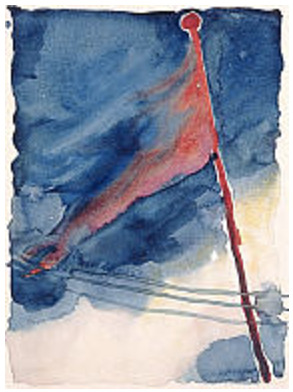The Flag (O'Keeffe painting) facts for kids
The Flag is a painting created by Georgia O'Keeffe in 1918. It shows her deep worry about her brother. He was sent to fight in Europe during World War I. This war was very dangerous because of new weapons. These included machine guns, mustard gas, naval mines, and torpedoes. There were also powerful artillery guns and warplanes. Because of a law called the Espionage Act of 1917, people could not speak freely. So, this painting was not shown until 1968. Today, you can see it at the Milwaukee Art Museum.
Why Georgia O'Keeffe Painted The Flag
In 1918, Georgia O'Keeffe felt very sad and worried about World War I. She stopped painting for three months. She understood why the war was happening. But like many Americans, she felt it went against basic human kindness and Christian beliefs.
O'Keeffe's brother, Alexius, was a soldier. He was stationed in Texas before going to Europe. She visited him in the fall of 1917. She was very anxious about what would happen to him. He was one of the first soldiers sent to France. He did not think he would come back alive. The war in France was especially dangerous. New weapons like poisonous gases could kill, blind, or badly hurt soldiers. Powerful, long-range guns caused huge destruction. Submarines placed mines in the sea. Airplanes dropped bombs from the sky.
O'Keeffe lived in Canyon and disagreed with many people there about the war. She did not like how some tried to make the war seem glorious. She tried to convince her male students to stay in school instead of fighting. She also wanted leaders to teach young men about the reasons for war before they went to battle. She even caused a stir when she asked a shop owner to remove Christmas cards. These cards had messages against Germany.
O'Keeffe became very sick with influenza during the 1918 flu pandemic. This flu killed millions of people worldwide. She took time off from her teaching job at the West Texas State Normal College. She went to a friend's ranch in San Antonio to get better. It was there that she painted The Flag.
What The Flag Painting Means
The Flag is both a political statement and a picture of O'Keeffe's fears. It shows a red streak that looks like "bleeding into bruise-colored clouds." In December 1917, she wrote that she felt she had to paint this picture. Her idea for the painting was a flag floating in the wind, like it was trembling.
Author Roxana Barry Robinson described the painting. She said, "O'Keeffe shows a drooping flag against a dark, starless sky. The flag hangs limply, without its stars and stripes. Its only color, and that of the pole, is blood red." Sadly, O'Keeffe's brother, Alexius, was gassed in France. He later died from the effects on January 7, 1930.
During World War I, speaking out against the war was made illegal by the Espionage Act of 1917. People in Canyon were uncomfortable with O'Keeffe's anti-war views. The Flag was first shown to the public on October 25, 1968. It was part of an exhibition at the Milwaukee Art Museum. The museum bought the painting in 1977. The painting was also shown in the "World War I and American Art" exhibition. This was at the Pennsylvania Academy of the Fine Arts in January 2017. Later, it was displayed at the New-York Historical Society.


